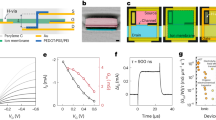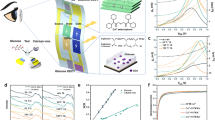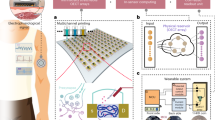Abstract
Organic electrochemical transistors can be used in wearable sensors to amplify biological signals. Other wireless communication systems are required for applications in continuous health monitoring. However, conventional wireless communication circuits, which are based on inorganic integrated chips, face limitations in terms of conformability due to the thick and rigid integrated circuit chips. Here, we report an ultrathin organic–inorganic device for wireless optical monitoring of biomarkers, such as glucose in sweat and glucose, lactate and pH in phosphate-buffered saline. The conformable system integrates an organic electrochemical transistor and a near-infrared inorganic micro-light-emitting diode on a thin parylene substrate. The device has an overall thickness of 4 μm. The channel current of the transistor changes according to the biomarker concentration, which alters the irradiance from the light-emitting diode to enable biomarker monitoring. We combine the device with an elastomeric battery circuit to create a wearable patch. We also show that the system can be used for near-infrared image analysis.
This is a preview of subscription content, access via your institution
Access options
Access Nature and 54 other Nature Portfolio journals
Get Nature+, our best-value online-access subscription
$32.99 / 30 days
cancel any time
Subscribe to this journal
Receive 12 digital issues and online access to articles
$119.00 per year
only $9.92 per issue
Buy this article
- Purchase on SpringerLink
- Instant access to full article PDF
Prices may be subject to local taxes which are calculated during checkout




Similar content being viewed by others
Data availability
The data that support the findings of this study are available from the corresponding authors upon reasonable request. Source data are provided with this paper.
References
Kim, D.-H. et al. Epidermal electronics. Science 333, 838–843 (2011).
Nawrocki, R. A. et al. Self-adhesive and ultra-conformable, sub-300 nm dry thin-film electrodes for surface monitoring of biopotentials. Adv. Funct. Mater. 28, 1803279 (2018).
Park, D. Y. et al. Self-powered real-time arterial pulse monitoring using ultrathin epidermal piezoelectric sensors. Adv. Mater. 29, 1702308 (2017).
Cho, H. et al. Real-time finger motion recognition using skin-conformable electronics. Nat. Electron. 6, 619–629 (2023).
Newman, J. D. & Turner, A. P. Home blood glucose biosensors: a commercial perspective. Biosens. Bioelectron. 20, 2435–2453 (2005).
Kim, J., Campbell, A. S., de Avila, B. E. & Wang, J. Wearable biosensors for healthcare monitoring. Nat. Biotechnol. 37, 389–406 (2019).
Lee, H. et al. Wearable/disposable sweat-based glucose monitoring device with multistage transdermal drug delivery module. Sci. Adv. 3, e1601314 (2017).
Sempionatto, J. R. et al. An epidermal patch for the simultaneous monitoring of haemodynamic and metabolic biomarkers. Nat. Biomed. Eng. 5, 737–748 (2021).
Tu, J. et al. A wireless patch for the monitoring of C-reactive protein in sweat. Nat. Biomed. Eng. 7, 1293–1306 (2023).
Zhang, M., Tang, Z., Liu, X. & Van der Spiegel, J. Electronic neural interfaces. Nat. Electron. 3, 191–200 (2020).
Lee, W. et al. Nonthrombogenic, stretchable, active multielectrode array for electroanatomical mapping. Sci. Adv. 4, eaau2426 (2018).
Wang, Z. et al. A flexible and regenerative aptameric graphene–Nafion biosensor for cytokine storm biomarker monitoring in undiluted biofluids toward wearable applications. Adv. Funct. Mater. 31, 2005958 (2020).
Nakatsuka, N. et al. Aptamer–field-effect transistors overcome Debye length limitations for small-molecule sensing. Science 362, 319–324 (2018).
Wang, B. et al. Wearable aptamer-field-effect transistor sensing system for noninvasive cortisol monitoring. Sci. Adv. 8, eabk0967 (2022).
Zhao, C. et al. Implantable aptamer–field-effect transistor neuroprobes for in vivo neurotransmitter monitoring. Sci. Adv. 7, eabj7422 (2021).
Rivnay, J. et al. Organic electrochemical transistors. Nat. Rev. Mater. 3, 17086 (2018).
Diacci, C. et al. Diurnal in vivo xylem sap glucose and sucrose monitoring using implantable organic electrochemical transistor sensors. iScience 24, 101966 (2021).
Pappa, A. M. et al. Direct metabolite detection with an n-type accumulation mode organic electrochemical transistor. Sci. Adv. 4, eaat0911 (2018).
Scheiblin, G., Coppard, R., Owens, R. M., Mailley, P. & Malliaras, G. G. Referenceless pH sensor using organic electrochemical transistors. Adv. Mater. Technol. 2, 1600141 (2017).
Guo, K. et al. Rapid single-molecule detection of COVID-19 and MERS antigens via nanobody-functionalized organic electrochemical transistors. Nat. Biomed. Eng. 5, 666–677 (2021).
Lee, W. et al. Integration of organic electrochemical and field-effect transistors for ultraflexible, high temporal resolution electrophysiology arrays. Adv. Mater. 28, 9722–9728 (2016).
Park, S. et al. Self-powered ultra-flexible electronics via nano-grating-patterned organic photovoltaics. Nature 561, 516–521 (2018).
Ji, X. et al. Mimicking associative learning using an ion-trapping non-volatile synaptic organic electrochemical transistor. Nat. Commun. 12, 2480 (2021).
Khodagholy, D. et al. In vivo recordings of brain activity using organic transistors. Nat. Commun. 4, 1575 (2013).
Kim, D. H. et al. Dissolvable films of silk fibroin for ultrathin conformal bio-integrated electronics. Nat. Mater. 9, 511–517 (2010).
Bariya, M., Nyein, H. Y. Y. & Javey, A. Wearable sweat sensors. Nat. Electron. 1, 160–171 (2018).
Gao, W. et al. Fully integrated wearable sensor arrays for multiplexed in situ perspiration analysis. Nature 529, 509–514 (2016).
Wang, M. et al. A wearable electrochemical biosensor for the monitoring of metabolites and nutrients. Nat. Biomed. Eng. 6, 1225–1235 (2022).
Deng, Y. et al. A flexible and highly sensitive organic electrochemical transistor-based biosensor for continuous and wireless nitric oxide detection. Proc. Natl Acad. Sci. USA 119, e2208060119 (2022).
Matsuhisa, N. et al. High-frequency and intrinsically stretchable polymer diodes. Nature 600, 246–252 (2021).
Kim, Y. et al. Chip-less wireless electronic skins by remote epitaxial freestanding compound semiconductors. Science 377, 859–864 (2022).
Keum, D. H. et al. Wireless smart contact lens for diabetic diagnosis and therapy. Sci. Adv. 6, eaba3252 (2020).
Ku, M. et al. Smart, soft contact lens for wireless immunosensing of cortisol. Sci. Adv. 6, eabb2891 (2020).
Takamatsu, T., Sijie, Y. & Miyake, T. Wearable, implantable, parity‐time symmetric bioresonators for extremely small biological signal monitoring. Adv. Mater. Technol. 8, 2201704 (2023).
Kim, H.-J. et al. Review of near-field wireless power and communication for biomedical applications. IEEE Access 5, 21264–21285 (2017).
Tang, H., Yan, F., Lin, P., Xu, J. & Chan, H. L. W. Highly sensitive glucose biosensors based on organic electrochemical transistors using platinum gate electrodes modified with enzyme and nanomaterials. Adv. Funct. Mater. 21, 2264–2272 (2011).
Kang, X., Mai, Z., Zou, X., Cai, P. & Mo, J. Glucose biosensors based on platinum nanoparticles-deposited carbon nanotubes in sol–gel chitosan/silica hybrid. Talanta 74, 879–886 (2008).
Dutta Gupta, S. & Jatothu, B. Fundamentals and applications of light-emitting diodes (LEDs) in in vitro plant growth and morphogenesis. Plant Biotechnol. Rep. 7, 211–220 (2013).
Jacques, S. L. Corrigendum: optical properties of biological tissues: a review. Phys. Med. Biol. 58, R37–R61 (2013); erratum 58, 5007–5008 (2013).
Jung, D. et al. Sustainably powered, multifunctional flexible feedback implant by the bifacial design and Si photovoltaics. Adv. Healthc. Mater. 10, e2001480 (2021).
Park, S.-I. et al. Printed assemblies of inorganic light-emitting diodes for deformable and semitransparent displays. Science 325, 977–981 (2009).
Khodagholy, D. et al. High transconductance organic electrochemical transistors. Nat. Commun. 4, 2133 (2013).
Canecki Varzic, S. et al. Assessment of FreeStyle Libre flash glucose monitoring system implementation in real life clinical setting: a prospective observational study. Diagnostics 11, 305 (2021).
Grieshaber, D., MacKenzie, R., Vörös, J. & Reimhult, E. Electrochemical biosensors – sensor principles and architectures. Sensors 8, 1400–1458 (2008).
Corrie, S. R., Coffey, J. W., Islam, J., Markey, K. A. & Kendall, M. A. F. Blood, sweat, and tears: developing clinically relevant protein biosensors for integrated body fluid analysis. Analyst 140, 4350–4364 (2015).
Zhang, S. et al. Intrinsically antifouling, soft and conformal bioelectronic from scalable fabrication of thin-film OECT arrays by zwitterionic polymers. Chem. Eng. J. 483, 148980 (2024).
Kaltenbrunner, M. et al. An ultra-lightweight design for imperceptible plastic electronics. Nature 499, 458–463 (2013).
Yang, Y. et al. A laser-engraved wearable sensor for sensitive detection of uric acid and tyrosine in sweat. Nat. Biotechnol. 38, 217–224 (2020).
Min, H. et al. Enhanced biocompatibility and multidirectional wet adhesion of insect-like synergistic wrinkled pillars with microcavities. Chem. Eng. J. 429, 132467 (2022).
Kim, S., Jahandar, M., Jeong, J. H. & Lim, D. C. Recent progress in solar cell technology for low-light indoor applications. Curr. Altern. Energy 3, 3–17 (2019).
Yin, L. et al. A stretchable epidermal sweat sensing platform with an integrated printed battery and electrochromic display. Nat. Electron. 5, 694–705 (2022).
Min, J. et al. An autonomous wearable biosensor powered by a perovskite solar cell. Nat. Electron. 6, 630–641 (2023).
Acknowledgements
We thank B. Jang (Korea Institute of Machinery & Materials) for advising on the μLED fabrication process. This research was supported by a Korea Institute of Science and Technology project (Grant Nos. 2V09233 to W.L. and J.-H.H., 2E32981 to W.L., 2E33141 to W.L., 2E33150 to W.L. and H.J., 2E32242 to J.-H.H. and 2E33122 to H.J.). This research was supported by the Nano Material Technology Development Program (Grant No. 2021M3H4A1A04092879) through the National Research Foundation of Korea funded by the Ministry of Science and ICT (W.L.). This research was also supported by the Bio & Medical Technology Development Program of the National Research Foundation funded by the Ministry of Science & ICT (Grant No. 2022M3E5E9016506 to W.L.), a grant from the Institute of Information & Communications Technology Planning & Evaluation funded by the Korea government through the Ministry of Science and ICT (Grant No. 2022-0-00208, Infrared long-range multi-devices wireless charging technology, to J.-H.H.), a National Research Foundation of Korea grant funded by the Korean government through the Ministry of Science and ICT (Grant Nos. RS-2023-00302145 to H.J. and 2021R1A2B5B03001691 to S.H.K.), the Graduate School of Converging Science and Technology Program of Korea University and the Korea Institute of Science and Technology (H.J.).
Author information
Authors and Affiliations
Contributions
K.Y.K. and W.L. designed the project and experiments. K.Y.K. and J.K. developed the biochemical sensor. K.Y.K. and S.S. fabricated the elastomeric battery circuit. K.Y.K., J.-H.H. and W.L. fabricated the μLED and integrated devices. K.L. and H.J. helped with using the glucose assay kit and with data analysis. S.-W.H., S.H.K. and H.J. helped in the data analysis. K.Y.K. and W.L. wrote the manuscript, and all authors revised it. J.-H.H. and W.L. supervised the project.
Corresponding authors
Ethics declarations
Competing interests
The authors declare no competing interests.
Peer review
Peer review information
Nature Electronics thanks Juliane Sempionatto, Tailin Xu and the other, anonymous, reviewer(s) for their contribution to the peer review of this work.
Additional information
Publisher’s note Springer Nature remains neutral with regard to jurisdictional claims in published maps and institutional affiliations.
Supplementary information
Supplementary Information
Supplementary Figs. 1–28 and Tables 1 and 2.
Supplementary Data
Supplementary data for Supplementary Figs. 1–28.
Source data
Source Data Fig. 2
Source data for Fig. 2.
Source Data Fig. 3
Source data for Fig. 3.
Source Data Fig. 4
Source data for Fig. 4.
Rights and permissions
Springer Nature or its licensor (e.g. a society or other partner) holds exclusive rights to this article under a publishing agreement with the author(s) or other rightsholder(s); author self-archiving of the accepted manuscript version of this article is solely governed by the terms of such publishing agreement and applicable law.
About this article
Cite this article
Kim, K.Y., Kang, J., Song, S. et al. An ultrathin organic–inorganic integrated device for optical biomarker monitoring. Nat Electron 7, 914–923 (2024). https://doi.org/10.1038/s41928-024-01237-6
Received:
Accepted:
Published:
Issue date:
DOI: https://doi.org/10.1038/s41928-024-01237-6
This article is cited by
-
Smart fiber with overprinted patterns to function as chip-like multi-threshold logic switch circuit
Nature Communications (2025)
-
All solution-processed organic field-effect transistors with low contact resistance via interface engineering for high-performance flexible circuits
Science China Materials (2025)
-
Stretchable and low-voltage electrolyte gate organic thin film transistors based on ionic gel for glucose sensing
Science China Materials (2025)
-
Printable core-shell nanoparticles empower stable biosensing
Science China Materials (2025)



